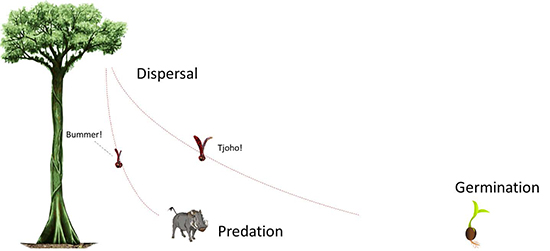Contact
Department of Wildlife, Fish and Environmental Studies
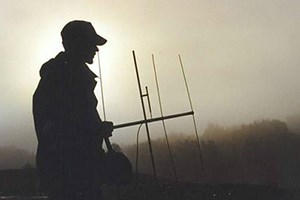
Do you want to work in forests, in arctic environments, on savannas, or in tropical rainforests? Are you interested in historical data, or spatial data such as animal movements or distribution of threatened species? Or perhaps you’d rather work in the DNA lab with molecular methods or species determination?
We offer a wide array of Master's thesis in the subjects of Forest Science, Biology, and Environmental Science!
The thesis can be included in the Conservation and Management of Fish and Wildlife Master's programme or as an independent course as part of a degree at another university. You can choose either a 30 or a 60 ECTS thesis. Master's thesis are offered all year round.
Our master's thesis connect to the subject areas at the department:
Below you find information on vacant master thesis and links to how the work can proceed. Click on the suggestions below to read more and see the names of contact persons.
Savanna woodlands are teeming with both plants and animals! Is one related to the other?
Savanna woodlands cover approximately 60% of Africa, and play important roles in human subsistence and carbon storage, while hosting a unique assemblage of animals and plants. Ecological theory suggests that plant and animal diversity may be related. However, human activities can impact both the plant and animal communities.
Recent studies have used animal-produced sound to study animal ecology. However, most of the studies using Passive Acoustic Monitoring (PAM) have occurred in northern, temperate areas, leaving much unknown about tropical soundscapes. PAM holds great potential for efficient large-scale wildlife monitoring. In the Faunal Activities for Climate Action (FACA) project, we have added wildlife monitoring to long-term subSaharan African vegetation plots, deploying AudioMoth acoustic recorders in plots in South Africa, Angola, Mozambique, and Madagascar.
We therefore have a unique opportunity to better understand the relationships between plants, animals, and humans in savanna woodlands. The objectives of this project are to 1) measure biodiversity in plots using acoustic methods, 2) determine if vocal animal diversity correlates with diversity in fruiting trees from long-term surveys, and 3) determine if human modification of landscapes disrupts this relationship. This is an excellent opportunity to gain experience using innovative technology at the forefront of ecological monitoring, and to join an international network of researchers, working toward a common goal.
The project is suitable for 60 credit thesis.
Sheila Holmes: sheila.holmes@slu.se
Are you interested in restoration ecology and getting a research experience on a topic with a high societal impact? Would you like to do a master’s project with field work during the summer months? Come and join our new project on wetland restoration!
About 1.5-2.0 million hectares of natural peatlands have been drained during the past century in Sweden. To counteract this, rewetting drained boreal forest is a promising measure to reduce carbon emissions in the face of climate warming, to increase water quality and to improve human health and well-being. Despite a growing interest among policy makers, stakeholders and the forestry industry in and beyond Sweden, little is known about the consequences of wetland restoration on biodiversity.
By supporting the comparative inventory of a wide range of taxa including plants and invertebrates in restored and control sites across Västerbotten county, your project will enable to quantify the short-term effects of wetland restoration on biodiversity.
Feel free to contact us:
therese.lofroth@slu.se
pierre.tichit@slu.se
Department of Wildlife, Fish and Environmental Studies.
Nature Conservation Agreement are voluntary agreements between a land owner and the State according to the Swedish Land Code, to, within a certain time period and with a certain level of economic compensation, take consideration on top of legal requirement to nature conservation values.
In total from 1993 up to 2023, 5,518 agreements have been made across the Swedish land base and forest types, covering close to 40,000 ha whereof 36,000 high productivity forestlands. The state investment has been in total ca 565 million SEK to private household forest owners.
A second type of small-area protection specifically between the state and private household owners, are the Biotope Protection Areas. These are normally up to ca 20 ha in size, oriented more strictly towards biodiversity protection, can be forced by the State, and are regulated under the Environmental Code.
In total since 1994 up to 2023, 8,914 areas have been protected, covering 33,600 ha high productive forest and 34,800 ha land area. The state investment has been in total ca 3,117 billion SEK to private household forest owners. Whereas a share of the protected area is set aside for natural, free development, another share is with ecological restoration management. The type of restoration includes, e.g., to favor old trees, broadleaf trees, prescribed burning, creating dead wood, veteranization of trees, and grazing by livestock.
Employing a database on NCA and BPA with a range of data that describes the initial and expected future conservation quantities and qualities, more narrow Bachelor or more broad Master thesis project can be arranged to study, e.g, protection of certain forest types, restoration schemes, ecological representativeness, county and/or biome distributions, temporal trends, economic investment, etc. For Master projects, GIS-skills are required.
The projects contribute to the capacity building concerning, a.o., the implementation of the EU Nature Restoration Law and the EU Biodiversity Strategy.
Providing parental care is one way by which parents can improve the fitness of their offspring. It is therefore surprising and counterintuitive that, in some species, parents will regularly kill and consume some of their own offspring (infanticide and filial cannibalism) or tolerate their own offspring killing and consuming each other (siblicide and sibling cannibalism). Both partial brood filial cannibalism and parent-tolerated sibling cannibalism can be viewed as bet-hedging strategies by which parents can pay a cost in terms of their offspring production, but then redirect parental resources to the remainder of their brood. But why do some species engage in filial cannibalism while others engage in sibling cannibalism? Are there any life history traits that predispose species to engage in one type of brood reduction strategy over another?
In this evolutionary biology project we will conduct a systematic review of published literature and life history trait databases to determine
This project would be a good fit if you are interested in working with new information and data, and if you are interested in having an office/lab-based masters’ project. It is especially a good fit for anyone interested in animal behaviour and evolution.
I am seeking a motivated and highly responsible student willing to learn new things. The work will involve searching literature databases (e.g., Web of Science, Google Scholar) and life history trait databases, extracting information from papers, and analyzing data to answer this broad research question. It would be ideal if the student is familiar with the statistical program R (but this can also be discussed/taught). Anyone interested in this research question and this type of Master’s thesis is encouraged to apply regardless of background.
I am part of the Aquatic Ecology Research Group at the Department of Wildlife, Fish and Environmental Studies.
Contact me with any questions you have!
Extent: 60 credits (1 year)
Aneesh Bose
Researcher, Department of Wildlife, Fish, and Environmental Studies aneesh.bose@slu.se
Hydropower is an important renewable energy source, to be supplied with modern environmental standards. Our project aims to provide an analyses tool to determine where in river networks conditions are most suitable for restoring lotic habitat with the purpose to increase the ecological function. Our study aims to provide scientific evidence that head is crucial for the abundance of grayling, trout and freshwater pearl mussel. We have mapped remaining fall height in 15 catchments and compared remaining fall heights with unregulated conditions and unregulated rivers. Scientific evidence will be provided with analysis of reaches with and without head, is compared with the corresponding unregulated reaches regarding environmental conditions. Through eDNA we determine the presence of fish and marcoevertebrater. The work results in a tool for detecting and prioritizing restoration measures without significant loss of electricity production.
Environmental DNA (eDNA) has received increased attention as an indirect genetic marker for inferring species presence during biodiversity monitoring. eDNA is defined here as genetic material that is shed from organisms through feces, body mucus, blood, and sloughed tissue or scales and suspended in environmental samples such as water.
The project answers scientific questions and gives evidence if reaches with fall height have a higher natural values and biodiversity.
The project will consist of analyses of eDNA metabarcoding results and remaining head in regulated rivers. We will provide data and results from eDNA sampling (fish and macroinvertebrates), remaining head, flow and water surface to the student as well as electro fishing data. We have data from 26 reaches with a geographical distribution from the Lule River to the Ljungan River in the south.
Analysis of remaining fall height will be linked to the Electrofishing database, river pearl mussel occurrence and eDNA study.
If you are a student interested in river ecology, hydrology, hydropower, biodiversity and restoration this is a project for you! You need knowledge in ArcGIS and statistics, since it will be a tool in the analysis.
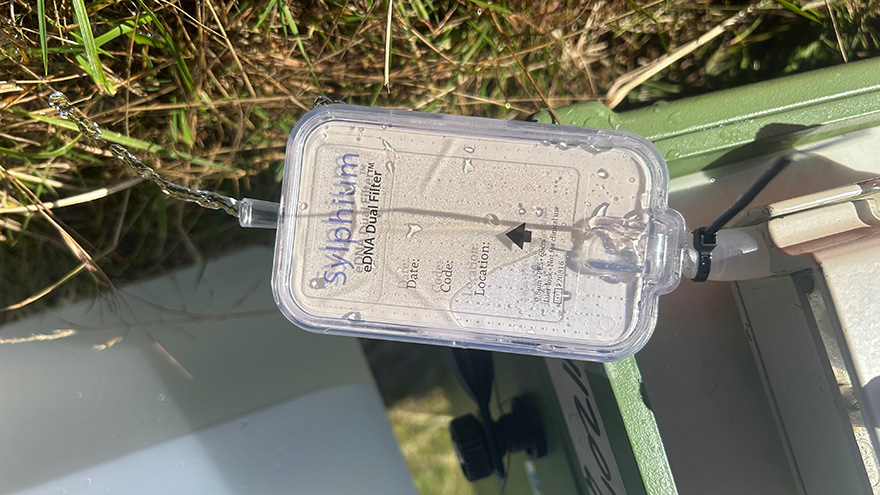
Filter for eDNA measurement. Photo: Åsa Widén, SLU
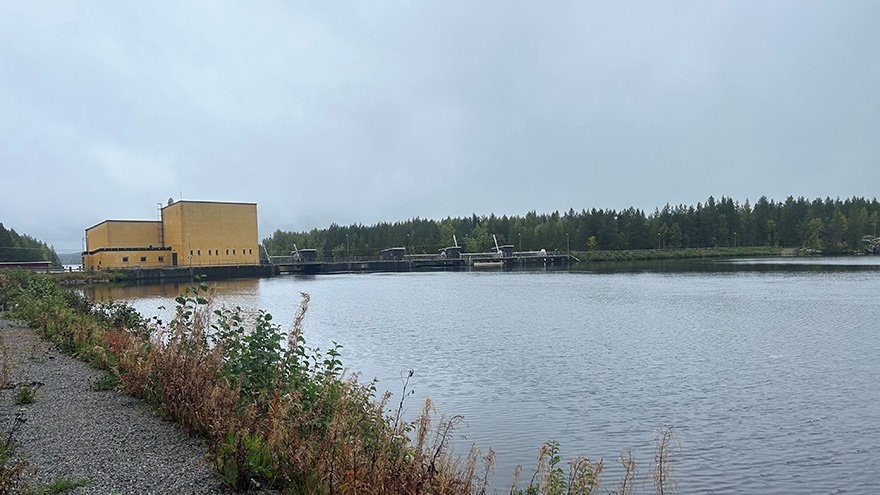
Power plant in Ljungan. Photo: Åsa Widén, SLU
Contact Åsa Widén if you are interested.
Åsa Widén, Department of Wildlife, Fish, and Environmental Studies (Project leader), 076-776 30 77, asa.widen@slu.se
Current technology of tracking individual fish in the wild relies on catching, handling and tagging fish to obtain positional data on their movement. This is costly, requires trained personnel and may cause stress and injury to the fish. Indeed, if the goal is to obtain high resolution data on fish movement over space and time, attaching active transmitters to the animal might be the only option. However, many research questions and management goals related to fish passage efficiency can be answered with just a few data points on each individual fish. Traditionally PIT technology (passive integrated transponder) have been used extensively for this purpose. It is a cost effective alternative of fish tracking but still requires the fish to be caught, tagged and handled. As an alternative, this project aims to use underwater camera traps to capture the spot patterns on migrating salmonids and use this for identification. The spots on salmonids are a unique signature for each individual and reported to be consistent over time (Stien et al. 2017), see Figure 1. Hence, it is possible to connect individual fish at different times and sites during their spawning migration, which would be an important tool when evaluating fish passage success and migration time for many individuals with a minimum effort.
The project is a collaboration between SLU and Vattenfall AB and we currently looking for master student to write a thesis within this project during spring 2024. The focus will be to develop an automated algorithm for spot location from video material at two different sites in Umeälven, the river mouth and above the fishway at the lower most hydropower plant Stornorrfors. Data from two years are already available and the student will also have the opportunity to assist with data curation for the migration season 2024.
The student will work in close collaboration with the Vattenfall AI team that already have used the video material and developed algorithms for automated species identification, sex separation, origin (wild/hatchery reared) and health. This will be a continuation of this work where the next step is to be able to identify unique individuals. The proportion of successful fish passages and their migration time from the river mouth to passing the dam will provide valuable insight when evaluating measures to facilitate fish passage at the Stornorrfors hydropower plant.

Figure 1. Example of an Atlantic salmon passing the lower camera trap in Umeälven at two different times. The spots on the operculum are here manually marked as an example of the purpose for the automated algorithm.
Johan Leander, johan.leander@slu.se
Stien, L. H., Nilsson, J., Bui, S., Fosseidengen, J. E., Kristiansen, T. S., Øverli, Ø., & Folkedal, O. (2017). Consistent melanophore spot patterns allow long‐term individual recognition of Atlantic salmon Salmo salar. Journal of Fish Biology, 91(6), 1699-1712.
Forest understory biodiversity and functioning often depend on specific temperature and moisture conditions under tree canopies. Compared to open areas with short vegetation, forest microclimates are characterized by buffered temperature extremes, i.e., cooler day-time and warmer night-time temperatures. Thus, forests have the potential to buffer adverse effects of extreme weather, like heat waves or droughts. However, this buffering capacity varies in space and time. In order to preserve microclimates during harvesting or to restore microclimates that support living and functioning forests we need to understand the dynamic microclimate landscape, and how topography, trees, ground vegetation and soil influence the variation in temperature and moisture.

Figure 1. Understory temperatures during a warm summer day. Different factors, like vegetation, water bodies and terrain shape the temperature landscape. Image: Caroline Greiser
Within the FORMAS funded ForestBuffer project, we have established a network of microclimate sensors in each of three SITES regions: Krycklan/Svartberget, Grimsö and Asa försökspark. Each site is equipped with two loggers, a temperature logger at weather station height and a temperature and soil moisture logger on the ground. We have collected data that are ready for use (2022 – 2023). Additionally, the student could visit the logger sites in one region (takes roughly 1 week) and collect new data.
The student can visit the chosen study region and, during this occasion, download logger data and collect any other data of interest, e.g. on forest stand characteristics, ground vegetation, lichen abundance, insect or fungal diversity, pollinators, moss growth rates, bilberry fruit set ...
Extent: 30 or 60 credits
Caroline Greiser, Stockholm University and Jörgen Sjögren, SLU
Caroline Greiser
Associated Researcher at the Department of Wildlife, Fish and Environmental Studies
Researcher at Department of Physical Geography, Stockholm University
caroline.greiser@su.se, +46 76 415 24 85
More information about the project
Jörgen Sjögren
Senior Lecturer at the Department of Wildlife, Fish and Environmental Studies, SLU
jorgen.sjogren@slu.se, +46 70 656 32 99
Riparian buffers are the primary tool in forest management for protecting the habitat structure and function of streams. They help protect against biogeochemical perturbation, filter sediments and nutrients, prevent erosion, contribute food to aquatic organisms, regulate light and hence water temperature, contribute deadwood, and preserve biodiversity. However, in even-aged management systems as practiced in Fennoscandia, understory trees have usually been cleared right up to the stream’s edge during thinning operations, especially around small, headwater streams.
In this project, the student will investigate changes and links between plant and insect community composition along gradients of waterway naturalness (small streams to ditches) and within the riparian buffers.
Vegetation measurements and insect trapping were carried out at different sites across Sweden this summer.
The task of this thesis is to quantify the insect community composition and relate it to the associated vegetation to answer a number of key questions:
We are looking for a motivated student interested in vegetation and insect ecology. Previous experience in identifying taxonomic groups of insects is a merit. Knowledge of R or the willingness to learn is also important. The project consists of laboratory work and desk-based study.
30 or 60 credits
Please send a letter of interest to Therese Löfroth (therese.lofroth@slu.se).
Co-supervisor: Robert Spitzer
Raptors are a key component of the ecosystem, determining its structure and long-term dynamics. A wide variety of raptor species such as eagles, owls, kestrels, buzzards, harriers, and hawks, inhabit the boreal forest landscape, however, the drivers of their distribution and dynamics are little known especially in relation to differences in their life history strategies, diets, habitat use and human impact on their populations and interactions.
This thesis project is aimed at developing a deeper understanding of raptor communities in the highly managed boreal forest landscape.
The candidate is expected to work in field and with survey methods and statistical modelling. The student should have a good working knowledge of survey methods, bird communities, R and GIS. A good ability to write in English is a plus.
Master Thesis Project in Ecology: 60 credits
Dr. Navinder J Singh
Senior Lecturer & Associate Professor
Quantitative Ecology Lab
Department of Wildlife, Fish, and Environmental Studies
Faculty of Forest Sciences
Swedish University of Agricultural Sciences
SE-901 83 Umea, Sweden
O: +46 (0)90 786 8538;
M: +46 (0)70 676 0103
navinder.singh@slu.se

In managed forest landscapes, biodiversity values can suffer. Ecoparks are
approaches to a forest management that combines goals for wood production
and nature conservation with a higher ambition for the latter within larger
landscapes (www.sveaskog.se). Across Sweden, Sveaskog – the state-owned and nationally largest forest owner – has established 37 different ecoparks. A main focus is on preserving and restoring high nature values as well as improving ecological conditions and in the end ecological functionality within the context of a larger managed forest landscape to support environmental goals.
At the time of their establishment, ecoparks commonly have very different departure points, resulting in individual strategic and tactical directions as well as spatial and temporal operational planning.
In temperate and boreal forests, resident breeding birds are used as indicators for a set of high nature values with different groups being indicators for different nature values (www.sverigesmiljomal.se, Erlington et al. 2012). Similar to birds, bats are also important indicators for habitat quality and ecological functionality, including structural complexity in managed forest ecosystems and monitoring of restoration effects in hardwood forests (Jones et al. 2009, EU bat 2013, Blakey et al. 2017, Caldwell et al. 2019, Green et al. 2020, Leidinger et al. 2020).
Following technical advances, automated passive acoustic monitoring (PAM, also called ecoaucostics) and publications on studies using PAM have increased largely during the past decades (Gibb et al. 2019, Sugai et al. 2019a, Stonwell and Sueur 2020), including applications in terrestrial ecosystems (Sugai et al. 2019b). PAM allows monitoring of faunal and ecosystem conditions across different spatiotemporal scales.
To study the effect of restauration favouring deciduous trees on species richness
in birds and bats, community structure, and the occurrence of bird species that
favour deciduous forest, we are looking for a student who is interested in
analyzing acoustic monitoring material gathered in a pilot study within the
ecopark Färna(Lat 59⁰N), province of Västmanland. The student will use the existing dataset on acoustic files on bird and bat sounds, comparing species occurrence in restored versus non-restored forest stands, and will link them to digital maps about forest stand features. With the focus on deciduous trees, the project also includes a GIS-analyses of occurrence and status of deciduous dominated forests in the ecopark and its immediate surroundings.
A motivated student that has good knowledge in R (e.g., spatial analyses, data handling) and statistics, and an interest in learning new software to analyze acoustic data. The project will be a desk-based study.
Extent: 30 credits
To apply: please send a letter of interest to Wiebke Neumann (Wiebke.Neumann[at]slu.se) explaining your suitability for the project.
Co-supervisors: Johan Svensson, Anne-Maarit Hekkala
Blakey, R. V., Law, B. S., Kingsford, R. T., & Stoklosa, J. 2017. Terrestrial laser scanning reveals below-canopy bat trait relationships with forest structure. Remote Sensing of Environment 198, DOI: 10.1016/j.rse.2017.05.038
Caldwell, K.L., Carter, T.C., & Doll, J.C. 2019. A Comparison of Bat Activity in a Managed Central Hardwood Forest. The American Midland Naturalist. https://doi.org/10.1674/0003-0031-181.2.225
Eglington, S.M., Noble, D.G., Fuller, R.J. 2012. A meta-analysis of spatial relationships in species richness across taxa: birds as indicators of wider biodiversity in temperate regions. Journal of Nature Conservation, https://doi.org/10.1016/j.jnc.2012.07.002
EU bats 2013. European bat population trends – a prototype biodiversity indicator. Technical report 19/2013. https://www.eea.europa.eu/publications/european-bat-population-trends-2013
Gibb, R., Browning, E., Glover-Kapfer, P., Jones, K.E. 2019. Emerging opportunities and challenges for passive acoustics in ecological assessment and monitoring. Methods in Ecology and Evolution. DOI: 10.1111/2041-210X.13101
Green, N.S., Wildhaber, M.L., Albers, J.L.. Pettit T.W., Hooper, M.J. 2020. Efficient Mammal Biodiversity Surveys for Ecological Restoration Monitoring. Integrated Environmental Assessment and Management. DOI: 10.1002/ieam.4324
Jones, G., Jacobs, D. S., Kunz, T. H., Willig, M. R., & Racey, P. A. 2009. Carpe noctem: the importance of bats as bioindicators. Endangered species research. doi: 10.3354/esr00182
Leidinger, J., Weisser, W.W., Kienlein, S., Blaschke, M., Jung, K., Kozak, J., Mosandl R., Michler, B., Ehrhardt, M., Zech, A., Saler, D., Graner, M., Seibold S. 2020. Formerly managed forest reserves complement integrative management for biodiversity conservation in temperate European forests. Biological Conservation,https://doi.org/10.1016/j.biocon.2020.108437.
Sugai, L.S.M., Silva, T.S.F., Ribeiro, J.W., Llusia, D. 2019a. Terrestrial Passive Acoustic Monitoring: Review and Perspectives. Bioscience, DOI: 10.1093/biosci/biy147
Sugai, L.S.M., Desjonquère C., Silva, T.S.F., Llusia, D. 2019b. A roadmap for survey designs in terrestrial acoustic monitoring. Remote Sensing in Ecology and Conservation. https://doi.org/10.1002/rse2.131
Shaw, T., Hedes R., Sandstrom, A., Ruete, A., Hiron, M., Hedblom M., Eggers, S.,
Taylor Shaw, Raluca Hedes, Arvid Sandstrom, Alejandro Ruete, Matthew Hiron, Marcus Hedblom, Sönke Eggers, Grzegorz Mikusiński. 2021. Hybrid bioacoustic and ecoacoustic analyses provide new links between bird assemblages and habitat quality in a winter boreal forest. Environmental and Sustainability Indicators, https://doi.org/10.1016/j.indic.2021.100141.
Stowell, D. & Sueur J. 2020. Ecoacoustics: acoustic sensing for biodiversity monitoring at scale. Remote Sensing in Ecology and Conservation. https://doi.org/10.1002/rse2.174
Rodents are widespread in terrestrial environments globally, and play important roles in ecosystems and human society. Madagascar is home to some of the most unique animal assemblages in the world, including a diverse array of endemic rodents.
However, among the most prevalent rodents are the invasive black rat (Rattus rattus) and Norwegian rat (Rattus norvegicus). While much attention is given to the more charismatic species in this biodiversity hotspot, information is lacking on the ecology of this important group of mammals.
Through the project Rewilding Madagascar, we have placed motion-sensor cameras in forests, reforestation areas, and some disturbed forest and open areas within the humid forest region of Eastern Madagascar.
With a unique study design of placing both arboreal and terrestrial cameras, we have the opportunity to study not only the presence of different species of rodents in these various habitat types, but also their use of different forest strata.
There are multiple possible angles for a Master’s student to explore in this project, from pest or disease management to community ecology to behavioural ecology. The project is an opportunity to work in the exciting field of conservation technology, using noninvasive methods to collect large amounts of data on elusive species.
The project is suitable for a 60 credit thesis.
Main supervisor: Sheila Holmes (sheila.holmes@slu.se)
Co-supervisors: Tim Hofmeester, Yonas Meheretu
Arctic char and brown trout are highly valued fish in the Swedish mountain areas, and they often occur together in lakes. In the last decades, the fish species Eurasian minnow has also arrived in a large number of these lakes, and it is likely a competitor for resources in the littoral zone. Studies from similar systems in Norway show that minnow can indeed have a strong impact on brown trout diet as well as body growth. However, there is a knowledge gap on the interaction between minnow and Arctic char, and systems where all three species occur together are understudied as well.
The task of this thesis is to investigate how the presence of minnow affects the ecology of Arctic char and brown trout in Swedish mountain lakes. You will sample fish populations in a number of lakes in the Abisko area as well as lakes in Jämtland. You will compare the diet, habitat use, growth and size distribution of Arctic char, brown trout and minnow, and assess difference between lakes where minnow is present and is not. You will potentially perform sampling of benthic invertebrates, zooplankton, water chemistry and light climate, to characterize the lakes (dependent on lake choice). Analysis also include stomach contents, isotopic composition of fish, and aging and growth determination of fish with the help of otoliths.
Field work should be performed during summer 2023 (and/or possibly autumn). Shorter or longer projects (30 or 60 ects) are possible.
Extent: 30 or 60 credits
Supervisor: Karin Nilsson (main supervisor VFM, SLU) and Renee van Dorst (co-supervisor VFM, SLU)
Karin Nilsson
Researcher Department of Wildlife, Fish and Environmental Studies
karin.a.nilsson@slu.se, ++46907868277, +46702636155
Renee van Dorst
Postdoc Department of Wildlife, Fish and Environmental Studies
renee.van.dorst@slu.se
Arctic char and brown trout are highly valued fish in the mountain area, and they often occur together in lakes. A number of environmental factors can affect these fish, but we see that summer temperatures have increased and that the winter season is becoming shorter, which likely changes the competitive relationship between char and brown trout in favor of trout.
The task is to investigate if changes in species dominance relationships between char and brown trout have occurred in mountain lakes during the last decades. You revisit lakes in the Hemavan-Tärnaby region that have been sampled in the 1960’s. You will perform sample fishing and compare your data to records from the previous sampling to evaluate if and how the populations have changed. You will also perform sampling of benthic invertebrates, zooplankton, water chemistry and light climate, to characterize the lakes. Analysis also include stomach content, isotopic composition of fish, and aging of fish with the help of otoliths.
Field work should be performed during summer (and/or possibly autumn). Shorter or longer projects (30 or 60 ects) are possible.
Extent: 30 or 60 credits
Supervisor: Karin Nilsson (main supervisor VFM, SLU)
The project is performed in collaboration with Pär Byström (EMG, UMU), Gunnar Öhlund (VFM, SLU), the county board of Västerbotten and Sami villages.
Karin Nilsson
Researcher Department of Wildlife, Fish and Environmental Studies
karin.a.nilsson@slu.se, ++46907868277, +46702636155
 Photo: Anders Lundvall (left) and Karin Nilsson (right)
Photo: Anders Lundvall (left) and Karin Nilsson (right)
Both Greater kudu and moose are important ecologically, economically and culturally. Next to being major ecosystem engineers and prey for large predators, they are subject to intensive human harvest. Both species experience sex-specific mortality due to non-selective hunting and are a game subject to venison and trophy hunting (Annighofer & Schutz 2011, Apollonio et al. 2010).
Kudu and moose are large-bodied browsers that range across wide areas in Savannah and boreal forest ecosystems, respectively, thereby encountering different types of human land use. Their body size and mobility makes them vulnerable both to impacts of climate change and conflicts with human interests (Hetem et al. 2014, Velduis et al. 2019, Holmes et al. 2021).
Both species express a bimodal activity pattern (i.e. peaks in activity in the early morning and later afternoon when they switch habitat). Even though kudu is adapted to subtropical conditions and moose to cold conditions, both lower their activity under increased ambient temperatures (Owen-Smith 1998, Ericsson et al. 2015).
Besides their importance for ecosystem functioning and production of various ecosystem services, large-bodied ungulates come easily into conflicts with human interests too (e.g., vehicle-collisions, browsing damage; Pascual-Rico et al. 2021), which asks an effective Natural Resource management to mitigate these negative impacts.
Given the current knowledge available on these two large-bodied key species, we are interested in improving our understanding on the similarities and difference in the ecology and management of these two large-bodied browsers in forest ecosystems. We are therefore looking for an enthusiastic student who is interested in reviewing the current literature as well as analyzing kudu and moose activity in relation to time of the day and season and surrounding habitat.
The student will use an existing dataset on kudu and moose camera images from South Africa and northern Sweden and will link them to digital maps on ambient temperature and habitat features.
A motivated student that has good knowledge in R (e.g., spatial analyses, data handling), and statistics. The project will be a desk-based study. The project is expected to generate a peer viewed publication in an international journal.
The proposed Master thesis project will be co-supervised by Professor Jan Venter (Nelson Mandela University, South Africa), Associate Professor Wiebke Neumann and researcher Tim Hofmeester (Swedish University of Agricultural Sciences, Sweden).
Extent: 60 credits
Annighofer P, Schutz S. 2011. Observations on the population structure and behaviour of two differently managed populations of the greater kudu (Tragelaphus strepsiceros, Pallas 1766) in Namibia. European Journal of Wildlife Research 57, 895-907.
Apollonio, Andersen, R, Putman, R, 2010. European ungulates and their management in the 21st century. Cambridge University Press.
Ericsson G, Dettki H, Neumann W, Arnemo JM, Singh NJ. 2015. Offset between GPS collar recorded temperature in moose and ambient weather station data. Eur J Wildl Res 61, 919. https://doi.org/10.1007/s10344-015-0968-7
Hetem RS, Fueller A, Maloney SK, Mitchell D. 2014. Responses of large mammals to climate change. Temperature 1, 115-127. https://doi.org/10.4161/temp.29651
Holmes SM, Cromsigt JPGM, Danell K, Ericsson G, Singh NJ, Widemo F. 2021. Declining recruitment and mass of Swedish moose calves linked to hot, dry springs and snowy winters. Global Ecology and Conservation 27, e01594. https://doi.org/10.1016/j.gecco.2021.e01594.
Owen-Smith N. 1998. How high ambient temperature affects the daily activity and foraging time of a subtropical ungulate, the greater kudu (Tragelaphus strepsiceros). Journal of Zoology 246, 183-192
Pascual-Rico R, Morales-Reyes Z, Aguilera-Alcalá N, Olszańska A, Sebastián-González E, Naidoo R, Moleón M, Lozano J, Botella F, von Wehrden H, Martín-López B, Sánchez-Zapata JA. 2021. Usually hated, sometimes loved: A review of wild ungulates' contributions to people. Science of the Total Environment 801,149652. doi: 10.1016/j.scitotenv.2021.149652.
Veldhuis MP, Kihwele ES, Cromsigt JPGM, Ogutu JO, Hopcraft JGC, Owen-Smith B, Olff H. 2019, Large herbivore assemblages in a changing climate: incorporating water dependence and thermoregulation. Ecology Letters 22, 1536-1546. https://doi.org/10.1111/ele.13350
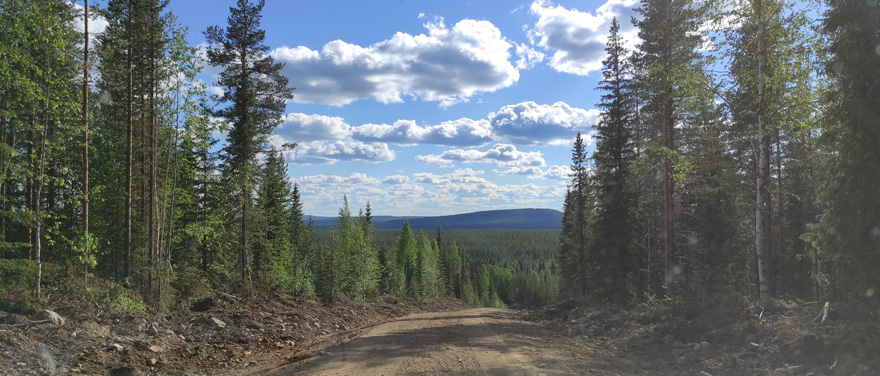
Ambitious global policies to reduce biodiversity loss and restore forest ecosystem integrity are critical to support ecosystem services we depend on. However, biodiversity continues to decline due, in part, to vague goals and policies that lack long term and consistent monitoring and reporting systems at multiple scales. In SUPERB, we propose a framework and an associated sampling design to monitor and report gains in Biodiversity and Ecosystem services (BES) induced by restoration projects. Ultimately, this system can be used to quantify the effectiveness of restoration, assess the cost-effectiveness of monitoring and conduct balanced evaluation of impact. In turn, this could promote the development of political and financial tools, incentivising forest owner, business, and government to protect and restore forest biodiversity and therefore deliver global climate and biodiversity goals.
This systematic design was deployed in 12 demonstration areas (Croatia, Czech Republic, Denmark, France, Germany, Italy, Netherland, Romania, Serbia, Spain, Sweden, UK) where various biodiversity and ecosystem services data have been collected using high throughput technology (remote sensing, passive acoustic monitoring, eDNA). Progress toward restoration objectives are now to be assessed and restoration effectiveness evaluated and reported in BES-report specific for each country.
In this 30-credit project, you will compile data, analyze and assess meaningful indicators to report trends in biodiversity and ecosystem services, quantifying their uncertainty and deducing overall restoration benefit in a consistent and reproducible way. All the analysis will be used as a basis for drafting the BES-demo report for a country, for which you will be responsible.
Several topics can be discussed according to the student interest. Topics could include:
Birch, Jennifer C., et al. "Cost-effectiveness of dryland forest restoration evaluated by spatial analysis of ecosystem services." Proceedings of the National Academy of Sciences 107.50 (2010): 21925-21930.
Bush, Alex, et al. "Connecting Earth observation to high-throughput biodiversity data." Nature ecology & evolution 1.7 (2017): 0176.
Hansen, Andrew J., et al. "Toward monitoring forest ecosystem integrity within the post‐2020 Global Biodiversity Framework." Conservation Letters 14.4 (2021): e12822.
Experience with a statistical language such as R and good written English.
Extent: 30 or 60 credits
Supervisor and contactperson: Alexandre Changenet alexandre.changenet@slu.se
Co-supervisors: Ruben Valbuena (Remote sensing division) and Johan Svensson (Wildlife, Fish and Environmental Studies)

Passive acoustic monitoring (PAM) offer the possibility to deliver biodiversity insight on vast scales at reduced effort and cost. Meanwhile, machine-learning algorithms now allow discriminating with confidence specific sounds of interest (specific taxa or specific disturbances). Hence, taxonomic diversity can be derived by isolating and identifying species calls, providing record of the biological community at any moment in space and time.
However, the quantity of data generated is huge and obtaining species level information at large spatio-temporal scale is challenging for a number of reasons: data storage expense, processing time, knowledge demand and missing automated identifiers and references databases for some taxa or regions. Sounds carry several functional features such as frequency and amplitude that vary across time and space, thus driving variation in acoustic trait diversity in the landscape. Soundscape ecology makes use of the soundscape (combination of all sounds produced), to make inference about ecological processes. Using acoustic indices that reflects some aspect of the diversity of acoustic traits, we can extract ecological information at minimized effort, cost and without the need for species identification.
Acoustic recording of bird and bats have been collected in different forest types in Sweden. Several developments are possible according to the student interest. Topics could include:
Bedoya, Carol, et al. "Automatic identification of rainfall in acoustic recordings." Ecological indicators 75 (2017): 95-100.
Kahl, Stefan, et al. "BirdNET: A deep learning solution for avian diversity monitoring." Ecological Informatics 61 (2021): 101236.
Luypaert, Thomas, et al. "A framework for quantifying soundscape diversity using Hill numbers." Methods in Ecology and Evolution 13.10 (2022): 2262-2274.
Wood, Connor M., et al. "Survey coverage, recording duration and community composition affect observed species richness in passive acoustic surveys." Methods in Ecology and Evolution 12.5 (2021): 885-896.
Experience with a statistical language such as R is essential; Interest in statistics and/or Bird/Bat ecology is an asset.
Extent: 30 or 60 credits
Contacts and main supervisor: Alexandre Changenet alexandre.changenet@slu.se
Co-supervisor: Navinder J Singh
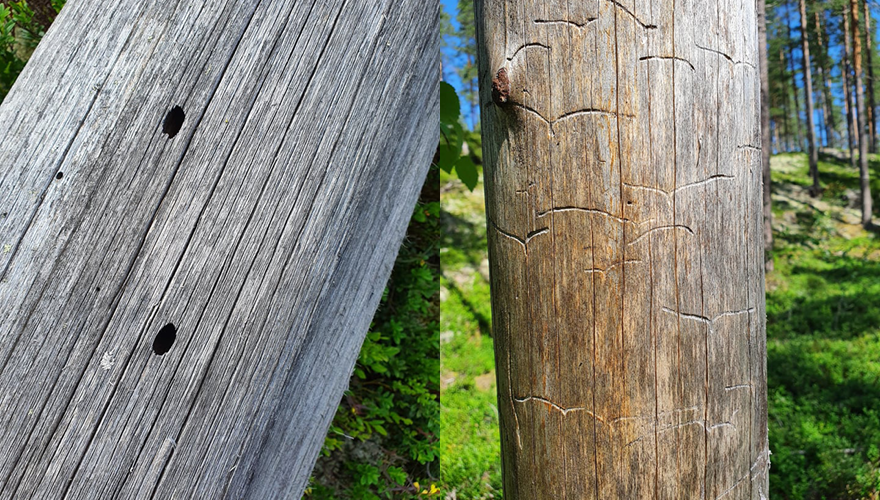
Emergence holes of Tragosoma depsarium (left) and feeding galleries of Tomicus minor (right) found in Effaråsen, Dalarna. Photo: Albin Larsson Ekström.
Modern forestry practices has led to a decline of available habitats as well as degradations and fragmentations of remaining habitats for many forest-dwelling species.
Beetles represent a large part of forest biodiversity and often play key roles in ecosystem functioning. Saproxylic beetles are important for e.g. tree death and deadwood decomposition. Due to their dependency on deadwood, a lacking structure in Swedish forests, and due to their often quick responses to disturbances, they are of great interest in research.
The aim of the thesis is to assess saproxylic beetle communities found on different substrates in stands treated with varying retention levels, deadwood enrichment and prescribed burning. It is possible to investigate the importance of substrate type and/or stand or treatment type to beetle communities, but other questions and hypotheses are welcomed.
Effaråsen is a Scots pine-dominated area situated in Dalarna, central Sweden. In 2012, a research project was initiated in Effaråsen and the forests were subjected to a number of treatments.
In total, there are 24 stands within Effaråsen, with each treatment being replicated in three stands each. The treatment types are as follows:
Retained trees in retention- and conservation concern stands were divided into 4 equal parts of: 1) green tree retention, 2) creation of high stumps, 3) partial ring-barking, 4) felling of trees to create deadwood logs.
The student will perform inventories of emergence holes and feeding galleries from saproxylic beetles and deadwood inventories in Effaråsen during the summer/fall of 2023. The substrates of interest are the ones created in 2012, namely: Created logs, created high stumps and partially ring-barked trees that have died and become snags.
The requirement of the student are as follows:
Extent: 30 or 60 credits
Supervisor: Therese Löfroth
Therese Löfroth
Researcher Department of Wildlife, Fish and Environmental Studies
therese.lofroth@slu.se, +46907868384, +46722289881
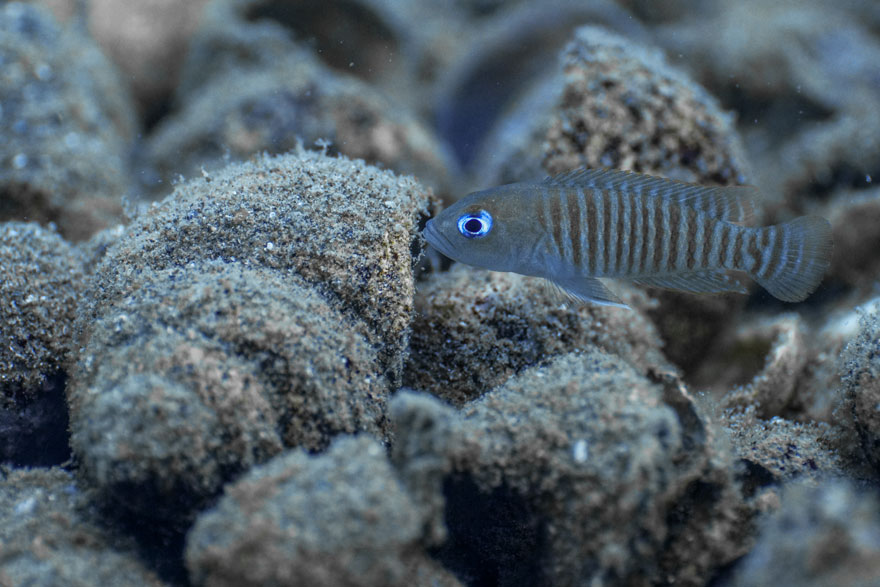
African cichlid fish, Neolamprologus multifasciatus, in the wild. Photo: Jakob Gübel
Aquatic organisms are exposed to ever increasing amounts of man-made chemicals, and pharmaceuticals represent a worrying class of emerging pollutants for wild animals. There has been a global rise in pharmaceutical pollution, with pharmaceuticals now being detected in many waterways where animals live. Pharmaceuticals are designed to alter human physiology and behaviour and this raises concerns that animals exposed to these drugs will also display altered behaviour. In order to understand what implications these pollutants have on animal populations, it is important that we understand how pharmaceuticals affect animal behaviour and reproduction.
We have conducted a large laboratory experiment where we exposed populations of Neolamprologus multifasciatus, to the pharmaceutical oxazepam. N. multifasciatus is a species of African cichlid fish that is highly social, meaning that it lives and reproduces in groups. They display many different behaviours, including territorial aggression, social submission, multiple mating, and habitat engineering. This makes N. multifasciatus particularly interesting to study from an ecotoxicological perspective because many possible behaviours may be altered by the pharmaceutical treatment.
In this experiment, groups of 15 fish (both males and females) were exposed to either a control dose, a low dose, or a high dose of oxazepam. The fish were then given 5 weeks to interact and reproduce in naturalistic aquariums (see picture below). Over this time, we took regular videos of the fish, and from these videos we will quantify their behaviours. We are employing exciting new techniques to quantify behaviour, including artificial intelligence/neural network models (but don’t worry! You don’t need to have a background in computer science to apply for this position!).
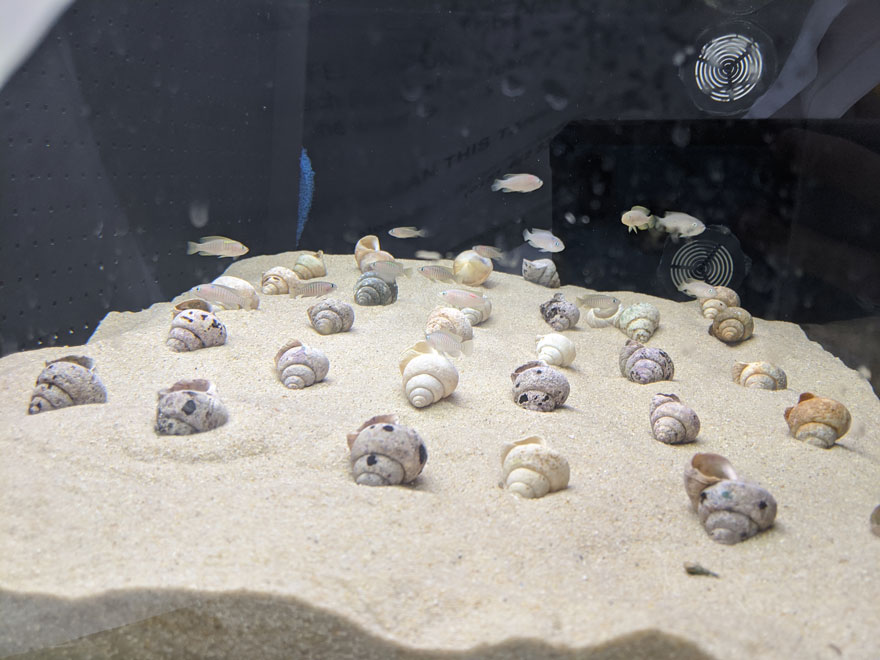
Neolamprologus multifasciatus groups in the lab experiment. The fish use empty snail shells as shelters and as breeding chambers.
Photo: Aneesh Bose
We are seeking motivated and highly responsible students willing to learn new things. You will work with data generated by the neural network, and this will involve annotating fish behaviour and tracks in a custom-made computer program. You will learn to analyze a variety of different kinds of behavioural data. You will gain experience in data entry, behavioural quantification, and movement tracking. I am eager to work with students from diverse backgrounds but having your degree in some form of natural science will give you a good background knowledge for this type of research (e.g., environmental science, biology, chemistry, ecology etc.).
Extent: 30 credits or 60 credits
Erin McCallum
Researcher Department of Wildlife, Fish, and Environmental Studies
erin.mccallum@slu.se
Aneesh Bose
Postdoctoral Researcher Department of Wildlife, Fish, and Environmental Studies
aneesh.bose@slu.se
We're part of the Aquatic Ecology Research Group at the Department of Wildlife, Fish and Environmental Studies. We are a dynamic group of researchers studying fish and aquatic environments. We always have new and interesting projects on the go that masters’ students can learn about and help with when they are completing their masters research project in our group.
Contact us with any concerns/questions you have!

Photo: Robert Spitzer
The sun parakeet (Aratinga solstitialis) used to exist across large areas of eastern South America, but is currently limited western Guyana and north-eastern Brazil. The wild population is considered endangered by IUCN (2022). One of the main causes for the decline in population is the capture of wild birds aimed at the pet trade. As of yet, the population size has not been estimated due to difficult logistics, but an estimate is essential for conservation efforts. Population size of a wild species is relatively easily accomplished using genetics with non-invasive sampling, but requires a substantial amount of work to set it up. Fortunately, this process has already been started through the development of a SNP chip aimed at discriminating between individuals in the population. With added specialty SNPs, the SNP chip can be made much more informative.
In this Master’s thesis project, the student will combine laboratory and data analysis work to identify variations in specific parts of the sun parakeet’s genome focusing on the mitochondria and sex chromosomes. With the newfound variations along with the SNP-chip data, the student can identify levels of relatedness within the wild samples to estimate the degree of inbreeding that may occur in the population.
Thesis: 60 credits
Supervisors:
Anita Norman, Researcher, SLU, Umeå
Robert Spitzer, Postdoc, SLU, Umeå
Anita Norman
Please provide information about why you are interested and why you think you are the right person to take on this study.
Food security is becoming an increasingly critical issue having been impacted by a global pandemic, climate-driven events and more recently the conflict in Ukraine. Localizing food production is an important solution to increasing food security everywhere, including northern Sweden. Since much of society has become dependent on globalized food supply, knowledge and experience in all aspects of cultivating food including planting, harvesting, preserving, storing, foraging, etc., is decreasing. This is especially true for northern Sweden which has a challenging climate for cultivating food due to its short, intense growing season making local historical knowledge even more important.
In this Master’s thesis project, the student will work within two or three rural communities in northern Sweden to access and preserve local knowledge on cultivating food. Through in-person focus groups, the student will collect accounts of how locals cultivate food both at present and in the past. Questions will be designed to provide information on:
Swedish language is necessary for this project.
Thesis: 60 credits
Supervisors:
Anita Norman, Researcher, SLU, Umeå
Tim Horstkotte, Research Scientist, Umeå University, Umeå
Anita Norman
Please provide information about why you are interested and why you think you are the right person to take on this study.
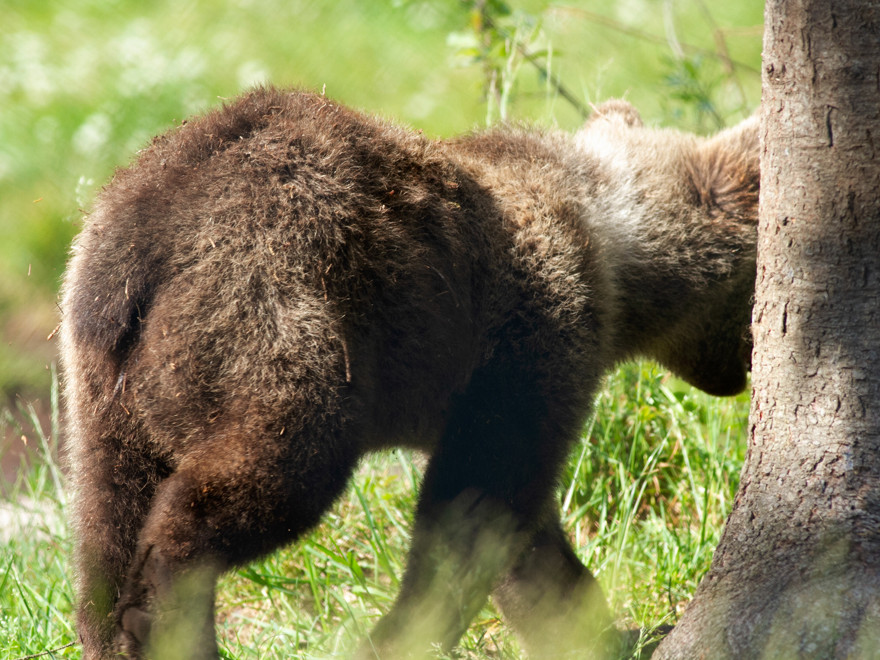
Photo: Jörgen Wiklund
The brown bear is an iconic species here in Sweden and has been the subject of extensive scientific study. However, there remain knowledge gaps which have been difficult to fill in the past due to a lack of appropriate tools. Fortunately, this is changing through a recent development in genetics that provides exceptional ability to determine how related brown bear individuals are to each other. Knowledge of relatedness within a population of brown bears over time can help refine current knowledge of mating patterns, dispersal and movement behaviours, and reproductive success among other population characteristics.
This thesis project will take advantage of time-series data collected on three occasions over the course of a decade (2009-2019) within the county of Västerbotten.
Thesis: 30 or 60 credits
Supervisors:
Anita Norman, Researcher
Göran Spong, Lecturer
Anita Norman, anita.norman@slu.se
Please provide information about why you are interested in this study and why you think you are the right person to take on this study.
The ocean is filled with different sounds originating from both abiotic and biotic sources. Abiotic sounds sources are mainly from surface motion with breaking waves, rain, thunder storms and wind, while biotic sounds arise from marine mammals, fish and invertebrates. All these sounds are natural parts of the marine acoustic environment and are referred to as ambient noise. Organisms living in the ocean use this acoustic landscape to navigate, find suitable habitats and food, and avoid predators. Many species of fish use acoustic signals to mediate social interactions. Acoustic cues and signals are especially important in water because sound is unique as a sensory modality propagating with little attenuation over long distances, at all depths, and irrespective of the water current direction. The full functions of these sounds are yet not fully understood but fish use acoustic signals to mediate social interactions, such as mate finding and mate choice, territory defence and predator warning. Acoustic signals may also possibly be used for species recognition, given the clear inter-specific differences in breeding sounds.
An additional and growing component in the marine soundscape is anthropogenic noise derived from human activities, such as shipping and recreational boats, as well as sources such as pile driving and seismic airgun. Regardless of the source, anthropogenic noise creates temporary and unpredictable fluctuations in the acoustic environment, leaving almost no marine area unaffected. Depending on the source and its characteristics, anthropogenic sound can have varying impact on the environment in which the sound is emitted. Many anthropogenic sound sources overlap with the frequencies fish produce and are able to detect, resulting in lost cues or signal detection. Lost cues can lead to missed mating opportunities having a direct effect on fitness. This overlap also force species using auditory signals to compensate for the increased background noise, including changes in the signal frequency, signal modality and temporal adjustments to signal production. Anthropogenic noise can also disrupt other auditory cues which marine organisms rely on to survive. Fish larva settlement for example is induced by reef sounds and this cue can be masked by anthropogenic noise.
Laboratory studies have shown that exposure to anthropogenic noise may cause hearing damage, physiological stress responses (elevated levels of stress hormones and increased heart-beat), disruption of foraging and anti-predator behavior and even death in fish. Despite this, we still lack basic knowledge of how fish are being affected by anthropogenic noise in the wild, e.g in lakes, rivers and oceans. This is partly due to the considerable technical challenges that has previously been involved in studying the behavior of free-ranging fish over large areas in natural environments. But also due to the inability to control for the multiple confounding biotic and abiotic factors present in field-studies, which makes it difficult to isolate the effects of anthropogenic noise, as well as produce valid experimental replication. This is unfortunate, as laboratory experiments have proven limited as a way to derive true ecological insight into the effect of anthropogenic noise on fish in the wild, due to the difficulty of replicating realistic soundscapes and exposure levels, as well as allowing the fish to express natural behavior. This makes extrapolation of laboratory results to the field problematic.
This project aim to investigate short- and long-term impacts of anthropogenic noise pollution on behavior and physiology of wild, free-roaming fish. Specifically, the project will quantify impact on three important dimensions in the life of fish; 1) space-use and habitat selection, 2) bioenergetics and stress and 3) within and between species interactions.
To do this, the project will apply an innovative combination of state-of-the-art remote sensing technologies able to track and monitor free ranging fish in high resolution over large areas, in combination with newly developed unique experimental facilities capable of conducting controlled and replicated fish behavioural studies at field scale.
We need a highly motivated and highly responsible student willing to learn new things. The work will involve particularly hard field work when collecting the fish from local lakes, tagging fish and keeping tagged fish in the lakes. The student will be working with help of supervisors most of the time.
Extent: 60 credits
Eva-Lotta Blom, postdoctoral fellow at Department of Wildlife, Fish, and Environmental Studies eva.lotta.blom@slu.se
Assoc. Prof. Gustav Hellström, Department of Wildlife, Fish, and Environmental Studies gustav.hellstrom@slu.se
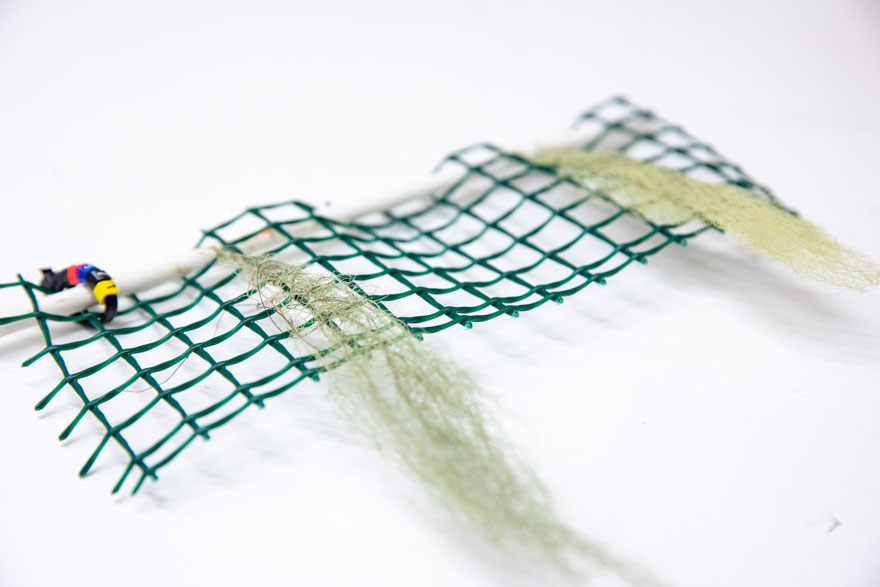
Background
Colonization processes of pendulous lichens after clear-felling are largely unknown. After clear-felling the pendulous lichen community in a forest stand is reduced to scattered remnants in retention areas. Some of the pendulous lichens are not well adapted to fast environmental changes, one such species, Alectoria sarmentosa is sensitive to clear-cutting and considered an indicator species of forest continuity.
Aim
The aim of this project is to investigate how the colonization process of pendulous lichens are affected by the vicinity of a source population.
Lukas Homström
lukas.holmstrom@slu.se
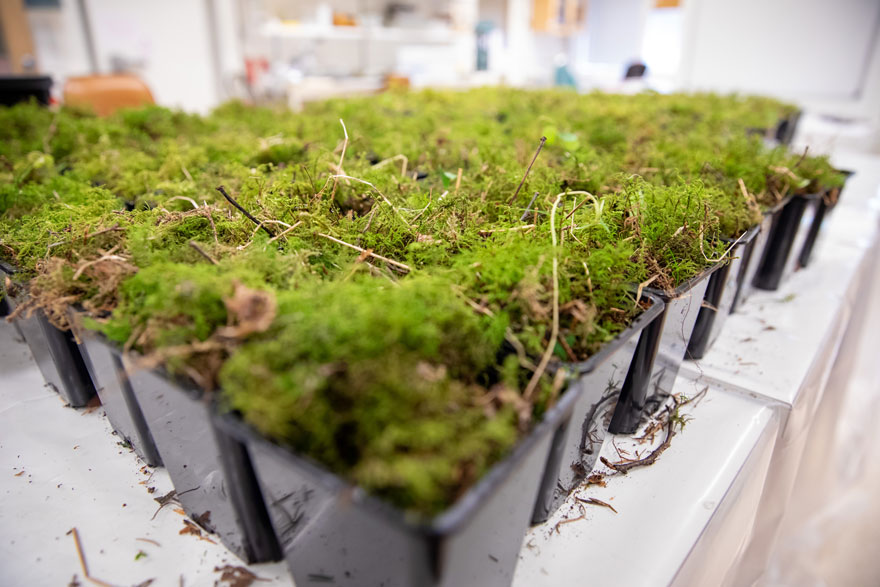
Background:
Forest floor conditions are affected by forestry operations, some operations such as clear-felling are well studied and the effects on the forest floor bryophytes are well understood. However, thinning operations are not well studied and how the forest floor microclimate is affected and the forest floor bryophyte community reacts to thinning is largely unknown.
Aim:
Investigate how three common forest floor bryophytes respond to commercial thinning in pine dominated stands.
Lukas Homström
lukas.holmstrom@slu.se
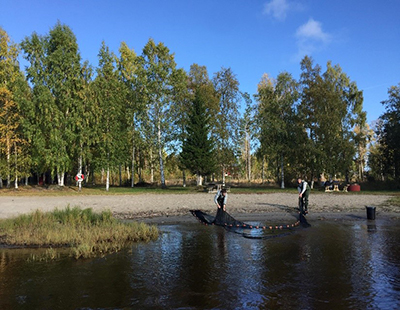 Photo: Alexander Vos
Photo: Alexander Vos Background
Pharmaceuticals represent an important group of contaminants present in the environment. Many of these compounds are an indispensable part of human lives, and their consumption has rapidly increased over the last few decades both for treatment of human diseases and for use in livestock husbandry. Also, the total number of different pharmaceuticals regularly used in human and veterinary medicine is increasing, as more than 4 000 pharmaceutically active compounds (PhACs) are currently being produced and marketed. Various classes of PhACs (e.g. antibiotics, antidepressants, anti-inflammatory drugs) then enter aquatic environments via sewage treatment plants (STPs) because these are often unable to remove such chemicals from municipal sewage water. Levels ranging from sub-ng L-1 to thousands of ng L-1 are reported for a wide range of pharmaceuticals in aquatic environments across the globe, indicating that PhACs are commonly occurring contaminants nowadays. Although such concentrations are not acutely toxic, they may still affect aquatic organisms in different ways, e.g. altering fish metabolism, inducing endocrine disruption, affecting early life development, or altering natural fish behavior. Specifically, psychoactive pharmaceuticals are a concerning threat to aquatic animals because they are designed to affect human behavior as part of the intended treatment (antidepressants, anxiolytics, antipsychotics) or as a side-effect of certain treatments (analgesics) and may affect aquatic wildlife similarly. To date, most research on adverse effects of PhACs in aquatic organisms focused on study of single compounds, even though animals are exposed to complex mixtures in the wild. Moreover, the influence of essential environmental factors (e.g. temperature, oxygen, pH) on the effects of PhACs in aquatic wildlife is poorly understood.
Project outline
The project will examine pharmacokinetics of three environmentally relevant psychoactive compunds in two aquatic species (one fish and one macroinvertebrate). Experiments will be done in laboratory conditions, where uptake from water, biotransformation (formation of metabolites in organisms), and depuration (elimination of pharmaceuticals and metabolites from organisms after removing the contamination from water) will be investigated. These processes will be studied at two different temperature regimes simulating the winter and summer seasons in the environment. As the temperature affect the metabolism of aquatic organisms in general, we expect it to affect the uptake and metabolic transformation of PhACs as well.
Work plan and timeline
Requirements: Motivated and highly responsible student willing to learn new things. The work will involve particularly hard field work when collecting the fish from local lakes (mostly beach seining), taking care of fish during acclimatization period and during the experiment, sampling blood and tissues of fish, and analysis of the data regarding the concentrations of PhACs measured in experimental organisms. The student will be working with help of supervisor most of the time.
Extent: 60 credits
Daniel Cerveny
Researcher Department of Wildlife, Fish, and Environmental Studies
daniel.cerveny@slu.se
Tomas Brodin
Professor Department of Wildlife, Fish, and Environmental Studies
tomas.brodin@slu.se
Modern forestry practices has led to a decline of available habitats as well as degradations and fragmentations of remaining habitats for many forest-dwelling species.
Fungi is a species-rich group with 80% of red-listed species being confined to forests. Wood-living fungi are also important decomposers of wood and serve as important microhabitats for many insect species. Fungi is therefore an excellent group to research, as they respond to changes in their habitat, and because they are so important for our forest ecosystems. The study will investigate different conservation and restoration measures in a Scots pine landscape.
The aim of the thesis is to assess fungal communities in stands treated with varying retention levels, deadwood enrichment and prescribed burning. It is possible to investigate the importance of substrate type and/or stand or treatment type to fungal communities, but other questions and hypotheses are welcomed.
Study area
Effaråsen is a Scots pine-dominated area situated in Dalarna, central Sweden. In 2012, a research project was initiated in Effaråsen and the forests were subjected to a number of treatments.

In total, there are 24 stands within Effaråsen, with each treatment being replicated in three stands each. The treatment types are as follows:
Retained trees in retention- and conservation concern stands were divided into 4 equal parts of: 1) green tree retention, 2) creation of high stumps, 3) partial ring-barking, 4) felling of trees to create deadwood logs.
The student will perform species inventories of wood-living fungi on select substrates in Effaråsen during the fall of 2021. The substrates of interest are the ones created in 2012, namely: Created logs, created high stumps and partially ring-barked trees that have died and become snags.
The requirement of the student are as follows:
Extent: 60 credits
Supervisor: Therese Löfroth
Therese Löfroth
Researcher Department of Wildlife, Fish and Environmental Studies
therese.lofroth@slu.se, +46907868384, +46722289881
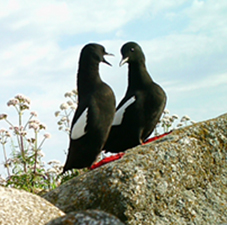 Photo: wildlife cam
Photo: wildlife camBackground: The Black Guillemot (Cepphus grylle) is a long-lived seabird with a circumpolar distribution. Recent research has indicated that large areas of the current breeding range in the Baltic Sea may be lost, and that reproductive effort varied substantially between two breeding seasons, in terms of breeding probabilities, clutch size and chick survival. Hence, under a changing climate, there is a need to understand important Black Guillemot behaviours and how these vary in relation to the parent’s body condition and the prevailing environmental conditions. Potential reproductive strategies to adverse foraging conditions include skipped breeding, reduced clutch sizes, brood reduction through parent-offspring interactions or decreased survival through sibling-sibling competition. Little is known about how Black Guillemot may adapt their reproductive strategy, given that they are a somewhat elusive species and that their behaviours are difficult to study as a result of them nesting on remote island locations, often at low densities and in burrows. In this study, we aim to get an understanding of how Black Guillemot will adapt their reproductive strategies to varying environmental conditions to aid nature conservationists in identifying appropriate conservation actions.
We are looking for a student for this fieldwork season to collect and analyse field measurements of the fitness of black guillemot parents and offspring in two Black Guillemot colonies located on islands in the Baltic Sea. The aim is to link the body condition of parents to reproductive investment and better understand resource-allocation strategies, for example between single or two egg clutches. Furthermore, camera traps will be placed outside nest boxes and paired with video cameras in nest boxes. Fieldwork is expected to last for 6 weeks from mid-June till the end of July and takes place on islands of the coast of Obbola. Analyses of the data after collection can be done at any location. You would be supervised by Anouschka Hof, who is currently located in the Netherlands, and Tomas Brodin (SLU-Umeå).
Also see https://project-black-guillemot.weebly.com/ for more information.
Keywords: seabirds, camera traps, behaviour, conservation
Requirements: We are looking for an enthusiastic candidate that preferably has some experience with handling birds.
Extent: 30 credits
Anouschka Hof
Department of Resource Ecology, Wageningen University & Research
anouschka.hof@wur.nl
Tomas Brodin
Researcher Department of Wildlife, Fish, and Environmental Studies
tomas.brodin@slu.se, +46907868161
Mutations have a strong contribution to genetic variation within plants, jet the broader consequences of plant mutation for ecosystems is not well known. We are seeking a motivated student for a MSc project aimed at exploring how mutation that influence leaf shape in birches also may influence arthropod communities and ecosystem processes.
Student will study arthropod communities in the canopies of mutant and wild-type birches planted in parks across the municipally of Umeå - the City of Birches. For a 60hp project the student will also collect senescent leaf litter from the same birches and conduct decomposition assays in streams.
Extent: 30 or 60 credits
Supervisor: Petter Axelsson
Petter Axelsson
Researcher Department of Wildlife, Fish and Environmental Studies
petter.axelsson@slu.se, +46907868361, +46793042878
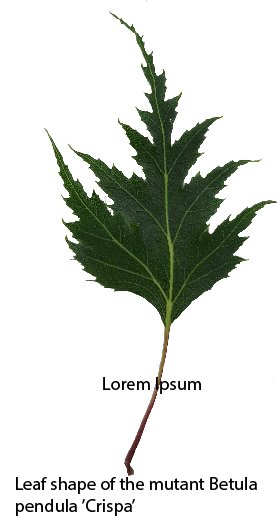
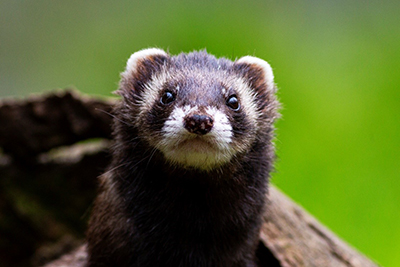 Photo: Tim Hofmeester, SLU
Photo: Tim Hofmeester, SLUWe are looking for enthusiastic students that want to do their MSc thesis within the "Swedish Polecat" project. In this project, we test a newly developed combination of a camera and hair trap to capture polecats. The overall aim is to develop a methodology to get population abundance estimates for the polecat in Sweden.
Thesis work consists of:
As this thesis topic requires several new skills, it is only available as 60 credit thesis.
Extent: 30 or 60 credits
Supervisor: Tim Hofmeester, Henrik Thurfjell
Tim Hofmeester
Researcher Department of Wildlife, Fish and Environmental Studies
tim.hofmeester@slu.se, +46702478842
Henrik Thurfjell
Environmental Assessment Specialist at the Swedish Species Information Centre
henrik.thurfjell@slu.se, +4618-672617, +4673-0402221
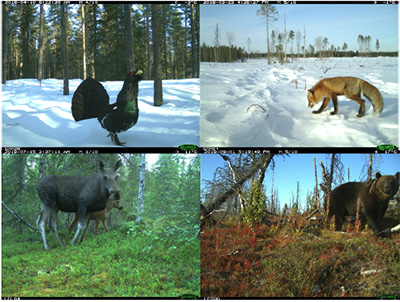
We are looking for enthusiastic students that want to do their MSc thesis within the ‘Scandcam’ project. In this project, we develop new camera trapping methods to study wildlife communities. The overall aim is to develop a system to monitor Swedish wildlife using camera traps.
Specific thesis topics could include:
There are possibilities to develop your own ideas.
There are possibilities for doing either a 30 credit (using existing data) or 60 credit (including own fieldwork) thesis.
Extent: 30 or 60 credits
Supervisor: Tim Hofmeester
Tim Hofmeester
Researcher Department of Wildlife, Fish and Environmental Studies
tim.hofmeester@slu.se, +46702478842
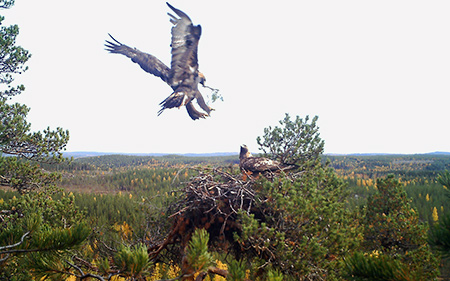 Photo: from camera trap, SLU
Photo: from camera trap, SLU
Background
Golden eagles sit at the top of the food chain in the boreal ecosystem and potentially rely equally on scavenging opportunities. Eagles are associated with predation on reindeer calves, however, there is little supporting knowledge on the fine scale movements of eagles in reindeer herding areas as well as individual level differences in foraging tactics between adults and young birds.
Aim
This 60-credit thesis project is aimed at developing a deeper understanding of golden eagle movements in reindeer herding areas.
Requirements: The student is expected to work with existing movement data on eagles and reindeer from Sweden. The student should have a working knowledge of R and GIS. A good ability to write in English is a plus.
Extent: 60 credits
Navinder Singh
Researcher Department of Wildlife, Fish and Environmental Studies
navinder.singh@slu.se, +46 (0)90 786 8538, +46 (0)70 676 0103
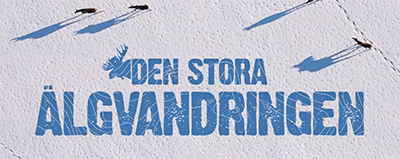 Photo: from SVT homepage
Photo: from SVT homepageBackground
Moose migrations are a fascinating phenomenon of boreal north that we have extensively studied in scientific research for decades, but also recently witnessed in the popular media through the SVT production “Den Stora Älgvandringen”. The intriguing aspects of the biology of moose revealed by the series provides an inspiring opportunity to increase our scientific knowledge on moose behaviour during migrations through the videos.
Aim
The main aim of this project is to systematically analyse video footage from the “Den Stora Älgvandringen” series to unravel new insights into moose migration behaviour. The project will be based at SLU and carried out in collaboration with the SVT crew and production team.
Requirements
Lots of patience and persistence, quantitative skills in data analyses and statistics, and excellent writing skills.
Extent: 60 credits
Navinder Singh
Researcher Department of Wildlife, Fish and Environmental Studies
navinder.singh@slu.se, +46 (0)90 786 8538, +46 (0)70 676 0103
A large part of the biodiversity of plants and pollinators in temperate and boreal zones are associated with open areas created by traditional human land use such as hay-making or cattle grazing. This biodiversity is now declining as a result of land abandonment and intensified farming. In the northern parts of Sweden extensive cattle grazing was commonly applied until the middle of the 20th century. In the last few decades, a decline in the numbers of farms and an increase in the number of horses for recreational use means that the number of horses now exceed the number of dairy cows in Sweden. The fact that many horses are kept under more extensive forms e.g. allowed to graze on abandoned farm land, means that there might also be great potential for horses to act as ecological restoration agents as for example shown by Garrido et al (2019). They showed that introduction of all year grazing by Gotland ponies led to increased biodiversity of both plants and pollinators. However, the question still remains if horses on summer pasture will have the same positive effect on biodiversity and how the grazing regime might be adapted to further increase biodiversity.
The aim with this project is to investigate if and/or under which circumstances horse grazing can create habitat for a multitude and magnitude of plants and pollinators. There will be opportunities to work with butterflies, bumblebees, moths or vegetation. The thesis will include field work with species monitoring in grazed and ungrazed areas in Västerbotten and adjacent counties. Depending on the extent of the work there are possibilities for both 30 and 60 credits thesis.
Extent: 30 or 60 credits
Supervisor: Therese Löfroth
Therese Löfroth
Researcher Department of Wildlife, Fish and Environmental Studies
therese.lofroth@slu.se, +46907868384, +46722289881
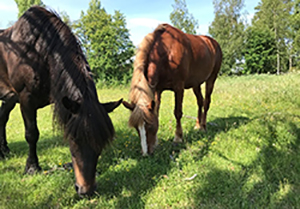
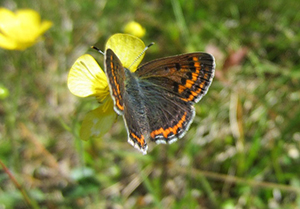
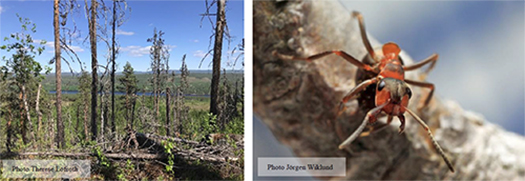
Forest fires have largely determined the post-glacial forest dynamics in the boreal region and are regarded as one of the most important boreal forest disturbances. Fires provide suitable habitat and key food sources for many organism groups and alter assemblage composition and densities of species in the soil and on the forest floor. The succession after fire is also different from that after clear felling and prescribed burnings might also differ from wildfires although this is still not evaluated. Because prescribed burning is used as a restoration tool in Sweden the effects are important to evaluate and in this project the comparison with wildfires are extra interesting.
Previous studies have suggested that the dominating mound building wood ants (Formica rufa group) are negatively affected by fire and that other ant species will become more abundant. However, so far the effects of forest fire on ants have only included short term effects and only prescribed fires. In this project natural wild fires as well as prescribed burnings and unburned control sites are included. Ants were sampled in pit-fall traps during 2019.
The aim with this masters thesis is to quantify the long term (>10 years) effects of large scale wildfire and prescribed burnings on the community structure of ants in northern boreal landscapes. Ants constitute an important part of boreal forest biodiversity and because of their interactions with many other taxa they are often considered keystone species or ecological engineers because they contribute significantly to ecosystem function. They also respond strongly to changes in their environment and are consequently good ecological indicators.
The work will consist of lab work with species identification of already collected ants from wildfire and prescribed fire areas and unburned control sites from northern Sweden and Northern Finland. There is also a possibility to collect more data with and mound surveys in the field. The work will be suitable for a 60 credit thesis but 30 credits might also work.
Extent: 60 or 30 credits
Supervisor: Therese Löfroth
Therese Löfroth
Researcher Department of Wildlife, Fish and Environmental Studies
therese.lofroth@slu.se, +46907868384, +46722289881
Background
Bats (order Chiroptera) are the most species-rich and threatened mammalian group in Sweden with nine of 19 in Sweden reproducing species being red-listed. As insectivores, bats are important for limiting the abundance of pest species. Globally, bats are together with rodents the species hosting most zoonotic pathogens. Rabies is one of the most serious disease that bats can spread to humans and antibodies against rabies have also been found in bats in Sweden. Recently, studies in especially South America have revealed that bats also can spread orthohantavirus; a virus group that mainly has been associated with rodents. These viruses can cause hemorrhagic fevers in humans and in Sweden, nephropathia epidemica (NE; Swedish: sorkfeber) is common in northern Sweden. In southern Sweden, a case of NE was diagnosed in 2019; a case that (due to the distribution range of the virus) can’t be caused by rodents. A reasonable hypothesis is therefore that the human case in southern Sweden is caused by bats.
Primary research questions
Work plan and methods
Extent: Preferably 60 credits (1 year)
Supervisor: Frauke Ecke
Frauke Ecke
Researcher Department of Wildlife, Fish and Environmental Studies
frauke.ecke@slu.se, +46907868642, +46702636155
Green infrastructure (GI) is a mainstream EU policy that can be defined as a strategic and operational planning of natural and semi-natural areas that specifically is designed to provide and mobilize ecological connectivity, conservation, ecosystem services and multi-functionality in ecosystems. For boreal landscapes, forests with continuity and other high conservation forest values have a critical role to secure such functions. Recently, detailed mapping of proxy continuity forests (pCF) have been completed for the boreal biome in Sweden. This data can be used to assess spatial network traits, in combination with, e.g., the national land-cover data and data on forests with high conservation values including protected areas and woodland key habitats, etc. This project will focus on mapping and analyzing the spatial distribution of actual and potential forest conservation areas on watershed scale from coastal lowlands to alpine highlands and from river valleys to watershed divides, for one or two main rivers in northern Sweden. Project outcomes will feed into the ongoing work by the County Administrative Boards and the Swedish Forest Agency on regional green infrastructure planning. The analyses will be based mainly on GIS-analyses and literature studies.
The project is suitable for a 30 or a 60 credit thesis. GIS-skills are required. It is possible to arrange more than one thesis on this topic.
Extent: 60 or 30 credits
Supervisor: Johan Svensson, Bengt Gunnar Jonsson, VFM
Johan Svensson
Researcher Department of Wildlife, Fish and Environmental Studies
johan.svensson@slu.se, +46907868333, +46730216880
The environmental act (miljöbalken) recognizes a range of different national land-use interests (NI), including e.g. Natura 2000, nature conservation, reindeer husbandry, contiguous mountain landscapes, recreational life and wind energy production. Thus, the NI-framework reflects ecological, socio-cultural and economic priorities. Most NIs are geographically demarcated with a land-use claim that have substantial power in regional and municipal comprehensive planning. However, an evident overlap exists between different NI, also between actually or potentially conflicting interests. With a focus on wind energy production in municipalities as case studies, this project will focus on assessing spatial traits among a selected number of other NIs as a basis for identifying conflict risks but also integration and synergy prospects, as input to multi-objective landscape planning. In addition and depending on the student’s own interest, the analyses can include also, e.g., forestland for forest production or high conservation value forests. Four municipalities are pre-selected (Gällivaare, Åsele, Falkenberg, Uppvidinge) whereof at least two should be included. The final set of municipality case studies will be discussed and agreed as part of the thesis planning process. The analyses will be based mainly on GIS-analyses and literature studies.
The project is suitable for a 30 or a 60 credit thesis. GIS-skills are required. It is possible to arrange more than one thesis on this topic.
Extent: 60 or 30 credits
Supervisor: Johan Svensson, Wiebke Neumann
Johan Svensson
Researcher Department of Wildlife, Fish and Environmental Studies
johan.svensson@slu.se, +46907868333, +46730216880
Wiebke Neumann
Researcher Department of Wildlife, Fish and Environmental Studies
wiebke.neumann@slu.se, +46907868117, +46706349051
Background
Emerging infectious diseases are an increasing burden to public health. More than 60% of all emerging infectious diseases are zoonotic (spread by animals) and more than 70% of these originate in wildlife with rodents representing the most important order. Identification of drivers of pathogen transmission among rodents and from rodents to humans is crucial to understand disease outbreaks.
In this context, the personality – boldness, exploration, activity, etc. – of rodent hosts and reservoirs is getting increased attention and is currently one of the hot topics in disease ecology. For example, in horizontally spread infections, we can expect bold rodents to run higher risk of both catching and transmitting pathogens than shy rodents that might avoid contact to conspecifics.
As a model system, you will study the bank vole (Myodes glareolus)-Puumala hantavirus system.
Primary questions
Work plan and methods
Extent: Preferably 60 credits (1 year)
Supervisor: Frauke Ecke
Frauke Ecke
Researcher Department of Wildlife, Fish and Environmental Studies
frauke.ecke@slu.se, +46907868642, +46702636155
How is the recruitment of broad leaved trees affected by habitat use patterns of beavers and ungulates?
In this project, we aim to investigate this question by combining remotes sensing, GIS and field studies that measure browsing patterns along riparian zones in multiple catchments across a latitudinal gradient in Sweden. We aim to achieve a landscape scale perspective of the impact of herbivores on ecosystem structure and function with potential recommendations for landscape and wildlife management.
Skills needed: field work, spatial ecology, GIS, R statistics
Extent: 60 credits
Supervisors: Navinder Singh, Frauke Ecke
Navinder Singh
Researcher Department of Wildlife, Fish and Environmental Studies
navinder.singh@slu.se, +4690 786 8538, +4670 676 0103
Frauke Ecke
Researcher Department of Wildlife, Fish and Environmental Studies
frauke.ecke@slu.se, +46907868642, +46702636155
Seed morphology is ecologically important for many plants as it influence the ability of dispersal, germination and regeneration. For example, characteristics of dipterocarp seeds such as wing size and weight of seeds could comprise a trade-off between long dispersal of small seeds with long wings, and high germination potential of large sized seeds. Furthermore, dispersal may also influence density dependence effects on predation.
We know that wing length and seed size can vary among seeds from different
mother trees, which could influence seed dispersal. However, we do not know how strong this affect is and how variation in dispersal influence germination success and the risk of seed predation.
In this project you will travel to Borneo to collect seeds from different mother trees, quantify their variation in seed morphology and test how this variation influence dispersal ability. You will further assess how variation in seed morphology and dispersal influence the possibility for successful regeneration.
The project could be divided on two students collaborating on experiments but working on separate parts of the project. You would need to fund your project via a Minor Field Studies (MFS) or similar funding.
Extent: one 60 credits or two collaborative 30 credits projects
Supervisor: Petter Axelsson, Daniel Lussetti
Petter Axelsson
Researcher Department of Wildlife, Fish and Environmental Studies
petter.axelsson@slu.se, +46907868361, +46793042878
Daniel Lussetti
Postdoctor at the Department of Forest Ecology and Management
daniel.lussetti@slu.se, +46907868559
